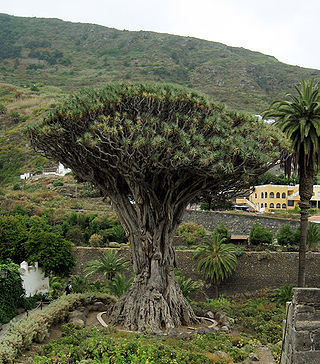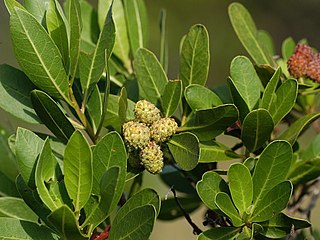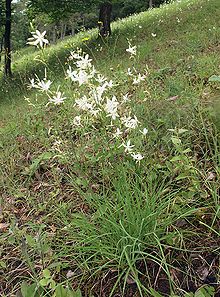
Vigna is a genus of plants in the legume family, Fabaceae, with a pantropical distribution. It includes some well-known cultivated species, including many types of beans. Some are former members of the genus Phaseolus. According to Hortus Third, Vigna differs from Phaseolus in biochemistry and pollen structure, and in details of the style and stipules.

Dracaena is a genus of about 120 species of trees and succulent shrubs. The formerly accepted genera Pleomele and Sansevieria are now included in Dracaena. In the APG IV classification system, it is placed in the family Asparagaceae, subfamily Nolinoideae. It has also formerly been separated into the family Dracaenaceae or placed in the Agavaceae.

Chlorophytum, is a genus of almost 200 species of evergreen perennial flowering plants in the century plant subfamily within the asparagus family. The plants are native to the tropical and subtropical regions of Africa, Australia, and Asia.

Cordyline is a genus of about 24 species of woody monocotyledonous flowering plants in family Asparagaceae, subfamily Lomandroideae. The subfamily has previously been treated as a separate family Laxmanniaceae, or Lomandraceae. Other authors have placed the genus in the Agavaceae. Cordyline is native to the western Pacific Ocean region, from New Zealand, eastern Australia, southeastern Asia and Polynesia, with one species found in southeastern South America.

Bulbinella is a genus of plants in the family Asphodelaceae, subfamily Asphodeloideae, first described as a genus in 1843. Many species are endemic to Cape Province in western South Africa, confined to the winter rainfall area. Other species are endemic to New Zealand, where they are most common in the central Otago region which enjoys a similar climate to the Cape Region of South Africa.

Conocarpus is a genus of two species of flowering plants in the family Combretaceae, native to tropical regions of the world. One of the species is a widespread mangrove species, and the other is restricted to a small area around the southern Red Sea coasts, where it grows alongside seasonal rivers.
The Koninklijke Algemeene Vereniging voor Bloembollencultuur, translated from Dutch as the Royal General Association for Bulb Culture, but more commonly known world-wide by the acronym of KAVB, is a trade association for the bulb horticulture sector, and was established in 1860. The association has a rural organization, within which regional groups and departments are active.

Bulbine is a genus of plants in the family Asphodelaceae and subfamily Asphodeloideae, named for the bulb-shaped tuber of many species. It was formerly placed in the Liliaceae. It is found chiefly in Southern Africa, with a few species extending into tropical Africa and a few others in Australia and Yemen.

Drimia is a genus of African, south European and south Asian flowering plants. In the APG IV classification system, it is placed in the family Asparagaceae, subfamily Scilloideae. When broadly circumscribed, the genus includes a number of other genera previously treated separately, including Litanthus, Rhodocodon, Schizobasis and Urginea.

Guettardeae is a tribe of flowering plants in the family Rubiaceae and contains about 748 species in 14 genera. Its representatives are widespread geographically and are found in the tropics and subtropics.
Clavija is a genus of flowering plants belonging to the family Primulaceae.









